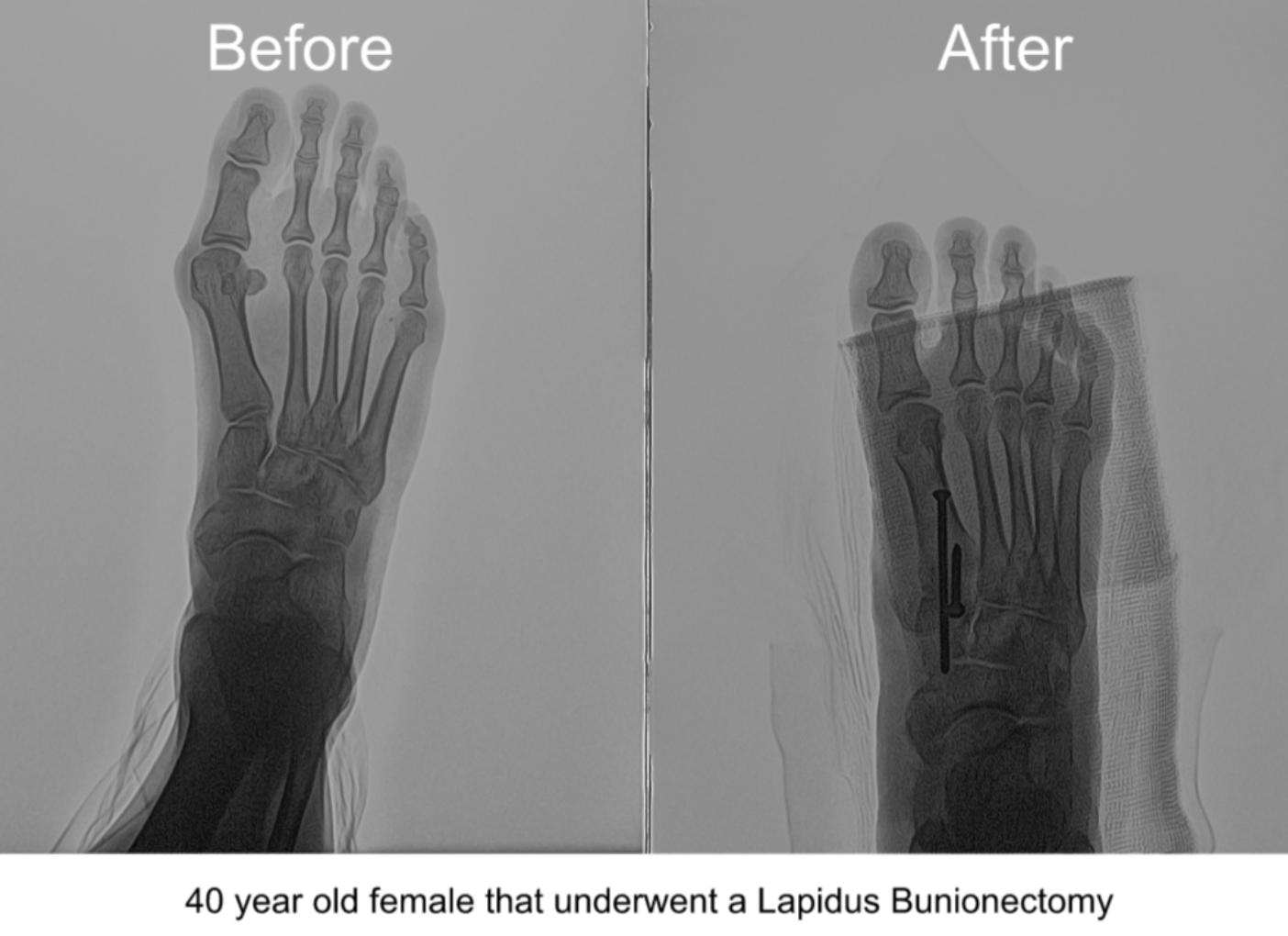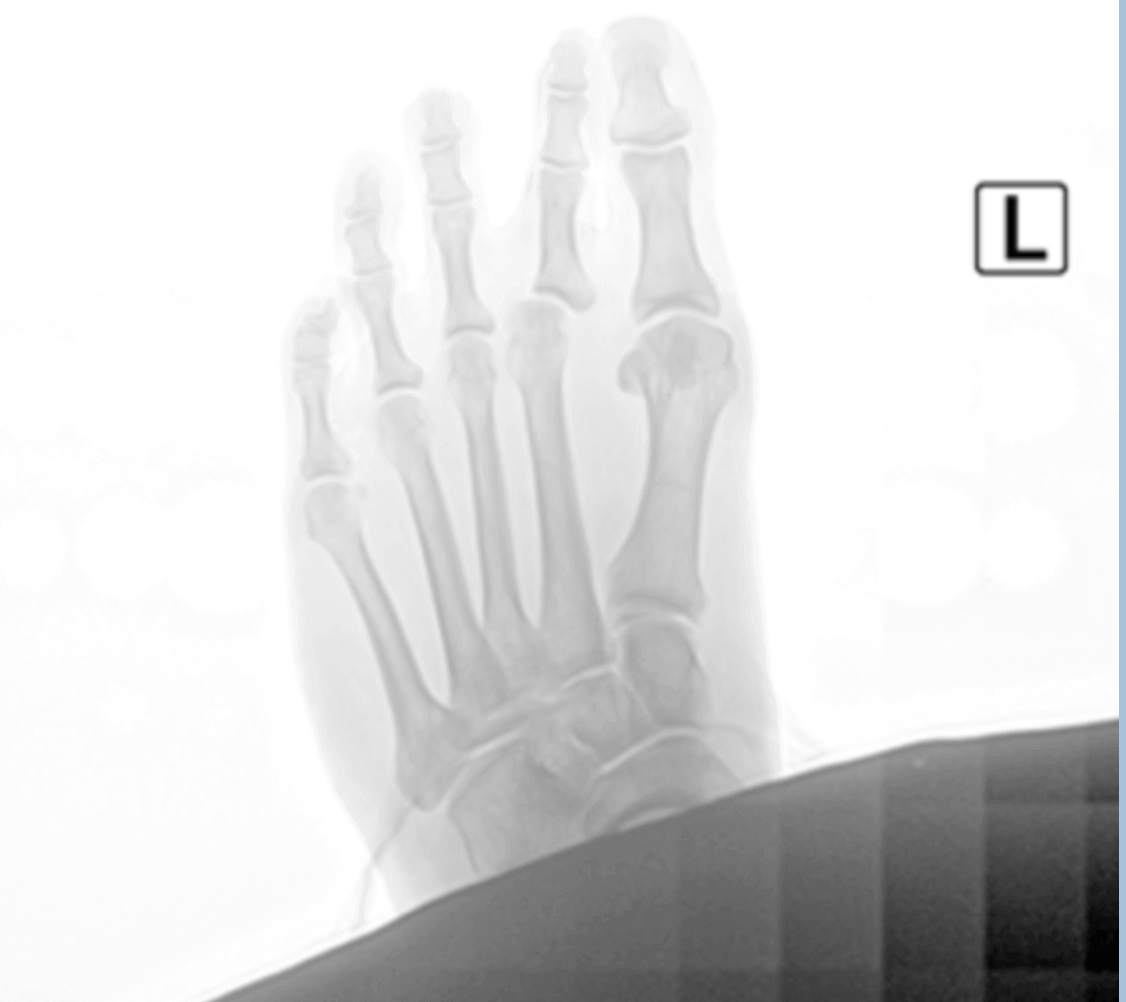bunion doctor
Displaying items by tag: bunion doctor
Dr. Timothy Young, a Board-Certified Foot Surgeon Discusses Removing Hardware After Bunion Surgery

Most bunion surgeries require screws or plates (or a combination). It’s important during bunion surgery, in order to get full correction and realign the bones and joints, the bone is typically resected or effusions are done to realign the first metatarsal. This requires hardware such as plates and screws. Once the hardware has done his job and the bone has healed and maintained the new corrected alignment and position, many of our patients elect to have hardware removed. The hardware can be medical grade stainless steel or titanium. These are the most common metal/metallic implants used.
Sometimes the head of the screw causes minor irritation or part of the threads protrudes enough that there is irritation with some of the adjacent soft tissue.
In other instances some patients seem to be sensitive to having a foreign body or a non-human item in the body. Some patients have minor skin manifestations although this isn’t common. In general patients feel better once the hardware is out.
If you are experiencing bunion pain, give us a call at 425-391-8666 or make an appointment online today.
Dr. Brandon Nelson, A Board-Certified Bunion Expert, Discusses When To Consider Bunion Surgery

Bunions can be very difficult for many patients. They can often be extremely uncomfortable and make walking unpleasant. Many people try going to larger shoes or wearing toe spacers or straps and padding. This can provide temporary relief however often make the bunion increase in size as larger shoes allow more room for the bunion to grow. The question I hear often is: “When do I have my bunion fixed?”.
When do I have my bunion fixed?
The answer for this is complex and is dependent on each patient and their lifestyle. I think the most important question is does the bunion impact the lifestyle you enjoy? If the answer is yes, it is time to fix it. If your bunion stops you from walking, hiking or even fitting in shoes the time has come.
How is my bunion fixed?
Bunion surgery has significantly progressed in recent years. The majority of bunions can be fixed with a simple procedure that takes less than 2 hours. Most often these can be done in our office and do not require any trips to the hospital. It is very common to be able to walk after surgery and maintain an exercise program with some modifications.
Is it painful?
I think it is important to realize all surgery can cause pain. The majority of our patients do very well with pain control. We have fixed 1000’s of bunions and have developed great post-operative pain control techniques.
Will my bunion come back?
The most important part of bunion surgery is procedure selection. Not all bunions are the same and therefore not all bunions can be fixed with the same procedure. It is vital to have and x-ray and a thorough evaluation of your foot. I also believe having somebody operate on your bunion that has vast experience with bunion surgery is something to consider as well.
I hope this was helpful and answered some common questions. You could be a candidate to have it fixed or even a candidate that we can employ some conservative measures. Please give us a call at 425-391-8666 or make an appointment online.
Dr. Nelson Discusses Bunion Pain Relief
.jpg)
Bunions can be a very difficult pathology to deal with as a patient. The majority of patients that have bunion pain are typically female between the ages of 25-55. Etiology of the bunion remains a mix of genetics and environmental factors like shoes and activity levels. Bunions can develop on the inside or the outside of the foot. Bunion on the inside of the foot can also be called metatarsus primus varus or hallux abductovalgus. Bunion on the outside of the foot is called a tailor’s bunion. Bunions can be extremely painful with activities especially as people change activities like beginning to run or do exercises that require a lot of movement.
There are many different options to relieve bunion pain. The options are categorized as surgical or conservative. From a surgical standpoint it depends on the severity of the bunion as to which procedure is selected as well as the recovery time is correlated to this. Conservative care can be useful for many patients that have a new onset of bunion pain or are not ready to have it fixed surgically. There are prescription orthotics that can be specifically used to address bunion pain as well as lubricating injection series to reduce the painful joint. I get a lot of questions about conservative measures about strapping and padding for the bunions however these measures do not typically work and will not reverse a bunion.
If you have bunion pain and would like to discuss either conservative or surgical measures we are here to help. Give us a call at 425-391-8666 or make an appointment online today.
Dr. Brandon Nelson Discusses How To Make Sure You Have The Correct Bunion Surgery

Issaquah Foot and Ankle Specialists has been performing bunion surgery for more than 20 years and have performed thousands of bunionectomies. Having performed so many bunion procedures has allowed us to perfect our skills and provide patients with the most up-to-date bunion procedures. Currently there are almost 50 different bunion procedures that can be performed. However, the majority of these procedures are divided into 3 categories;
1. fusion or arthrodesis
2. head procedures
3. base procedures
It is important to note that not everyone is a candidate for one of these procedures. I can tell you it is important to have the entire foot structure evaluated as well as having x-rays done. I continue to get a lot of second opinions in my office due to the fact that I do perform so many bunionectomies. I do really enjoy discussing bunions and bunion procedures with patients in providing him with answers further questions and help with their feet. If you’re suffering from a bunion and are contemplating conservative care or surgical care consider making an appointment with us today.
Dr. Brandon Nelson Discusses Bunion Surgery For Runners

I treat a lot of runners in the office for all sorts of foot and ankle pain. I am a runner myself and so I enjoy treating these patients. It seems as though a lot of runners have foot deformities and one of most common is a bunion. It is important to note that the bunion itself can grow larger with increased activities like running. Running and bunions can be challenging from a structural standpoint and from a pain reduction standpoint. I feel like I have a lot of tools at my disposal to help runners become pain free with activities.
The majority of runners I see are great conservative candidates and become extremely happy with their progress. There are a few patients that do not respond to conservative measures and require surgical intervention. It is very important for runners to seek a physician that has a lot of experience dealing with runners in their clinic. This is especially important when contemplating surgical intervention and I can tell you I am extremely cautious with procedure selection on runners. If you have a bunion and are getting pain with running you may be a candidate for conservative measures or surgical measures. I would love to help you keep running happy trails!
Give us a call at 425-391-866 or make an appointment online today.
Dr. Brandon Nelson Discusses What Causes a Bunion and How To Fix it Once and For All

Some patients begin to notice a bump that is developing on the inside of their foot. They start to get pain with walking and exercise and they wonder what is happening. Often a patient will visit the shoe store or seek advice from nonmedical personnel as to what it is. It is important when been dealing with medical issues to seek the advice of someone who has had years of training and experience in that particular field. Your foot and ankle health is essential for long-term well-being of your overall general health. Bunions are the most common cause of pain and irritation around the big toe joint. The bunion is a bony deformity that often appears as a protuberance around the joint.
The majority of bunion deformities are an inherited foot structure. Patients can often trace to other relatives that have similar foot conditions. The pathology itself continues to progress with time and there is no conservative measures that reduce or correct the deformity. It is important to understand that conservative measures can sometimes help alleviate pain and increase overall functional performance. However, the bunion can only be fixed surgically. The surgical procedures depend on the patient’s overall foot structure, degree of deformity and activity levels. All bunion deformities that require surgical correction are done in the office and no longer require any hospitalization. All bunion procedures that we perform at Issaquah Foot and Ankle Specialists allow patients to be weight bearing and do not require prolonged periods using crutches or knee scooters. If you have a bunion deformity and would like to have it evaluated for either conservative or surgical measures please give us a call at 425-391-8666 or make an appointment online today.
- bunion
- bunion surgery
- bunion treatments
- bunion surgery issaquah
- bunion surgery seattle
- bunion surgery bellevue
- bunion doctor issaquah
- bunion doctor bellevue
- bunion doctor seattle
- bunion doctor
- podiatrist issaquah
- issaquah podiatrist
- issaquah foot and ankle specialists
- dr brandon nelson
- dr timothy young
Dr. Timothy Young Talks About Bunion Anatomy

Most bunion problems involve an alignment issue with the underlying bones. The first metatarsal and the great toe become out of typical alignment. The joint itself become subluxed and is then prone to arthritis and adaptive changes.
Bunions can develop an early age. This is called juvenile onset. This involves the first metatarsal shifting away from the adjacent second metatarsal and the foot becomes wider. In some cases this involves a splayfoot. Also there is more risk of bunion formation when there is underlying metatarsus adductus. This is a genetic inherited foot structure. It is common to see other family members that have a bunion. Often times you can look to let say your mother or grandmother and find that they also have a bunion, because of this genetic pattern.
Tight shoes can speed the process up and make things worse! However, in general, you are born with a foot type that is prone to a bunion.
If you have concerns about a bunion, give us a call at 425-391-8666 or make an appointment online!
Dr. Timothy Young and Dr. Brandon Nelson.
Dr. Timothy Young Talks About Anesthesia and Bunion Surgery

Dr. Timothy Young Talks About Anesthesia and Bunion Surgery
Lapiplasty

Lapiplasty refers to a type of jig or guide that is used to preform bunion surgery. Issaquah Foot & Ankle Specialists has been executing the Lapidus bunion procedure for greater than 20 years. We have extensive experience with bunions and bunion surgery. We make all our recommendations of bunion surgeries based on our years of experience and thousands of procedures that we have performed. The Lapiplasty is the #1 bunion product in the US right now and helps to guide the surgeon in the correct cut, compression and fixation. The technique involves the surgeon:
1. Make the correction of the bunion before they cut
2. Preform precision cuts
3. Achieve controlled compression of joint surfaces
4. Apply multiplanar fixation for robust stability
The idea with the use of this system is to get reproducible results and the best possible outcomes for patients. If you have a bunion and are interested in getting the best possible results, give us a call at 425-391-8666 or schedule an appointment with us to see if you are a candidate for the Lapiplasty.
Minimally Invasive Bunion Surgery

Minimally invasive bunion surgery does provide a few advantages compared to traditional bunion surgery. It often can leave smaller scars, have a faster recovery speed and have less pain. The term minimally invasive is rather vague and can be misleading. The most important part of bunion surgery is proper procedure selection. Procedure selection is based on the clinical evaluation and x-rays.
Minimally invasive techniques do have limitations and are not useful in large bunion deformities. The best way to determine whether or not you are a candidate is to schedule an appointment with us. We have an onsite surgical suite and can provide you with all the details to make a decision. We are even able to offer conservative measures for bunion pain. Don’t delay we are here to help at Issaquah Foot & Ankle Specialists. Give us a call at 425-391-8666 today.







